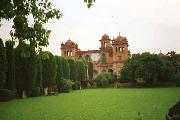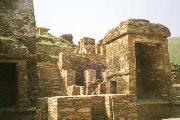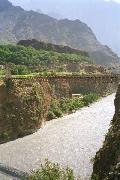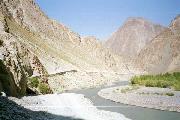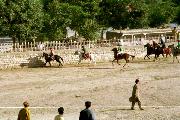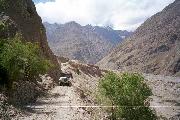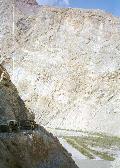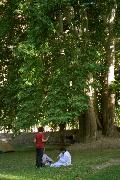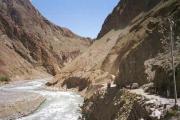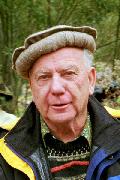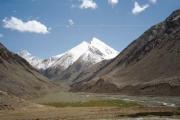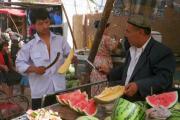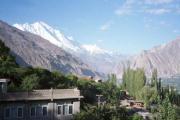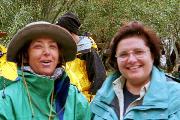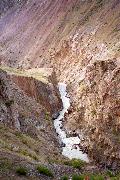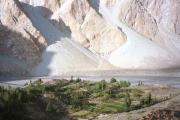The Upper Yarkhun
Thursday 26th August: Inkip to Kan Khun
I was up at 5.30am, packed, and washed with Hawas. PeterC was sick
(probably altitude), so I gave him some of my stemetil (he had lent his
to James). Hawas had a bag of French medicines, presumably left from
an earlier trekking party (a lot of French trekkers come to Pakistan)
and was suggesting that PeterC take some anti-histamines, which I don't
think would have helped...
The local people here were noticeably poorer than further down-river
and also more curious about us. I gave fifty rupee to an old women
everyone photographed. She spoke no Urdu, only "strali" (which I presume
was Chitrali/Khowar). A group of young girls
clustered around Ruth, who swapped her hairband with one of them, having
run out of pens to give away. They looked a lot older than they were: my
weak attempts at Urdu elicited much laughter but also their ages, I think.
Everyone was splitting luggage into three: some to leave behind,
some for the porters to carry, and a daypack to carry themselves.
Being a masochist, I left my daypack with surplus clothing and carried
everything else myself (but heck, it was only about eight kilograms).
Fernando and Covadonga were to go back to Mastuj with the unwanted
luggage: he was suffering from asthma.
We had breakfast at 7am, not 6.30 as planned... and there was much
aimless milling before we finally broke camp
(photo), with donkeys all over the
place (photo), porters everywhere
(photo),
lots of women and children, and a horse for Art.
 We walked through Lasht and then along a flat,
open stretch: Art was ahead, Ruth and I following,
others behind. There were views up side valleys (photo) and of glaciers across the
river (photo). We crossed Kan
Khun creek (I walked across and got my volleys wet, the others took off
boots or walked upstream to a bridge) and stopped for lunch.
We walked through Lasht and then along a flat,
open stretch: Art was ahead, Ruth and I following,
others behind. There were views up side valleys (photo) and of glaciers across the
river (photo). We crossed Kan
Khun creek (I walked across and got my volleys wet, the others took off
boots or walked upstream to a bridge) and stopped for lunch.
It was windy and raining a little. Our porters were sitting
in groups of three or four around fires, brewing tea (Photos:
1;
2),
and there were donkeys
everywhere.
(Photos:
2;
3.)
The full size of our party became
apparent for the first time.
Beverley was sick and others weren't well, so after lunch decided
to camp there instead of pressing on. It was not an ideal camp-site:
it was open and exposed (and very windy), the ground was hard, and
the only convenient water, Kan Khun creek, was dubious for drinking.
PeterC and I walked on for a kilometre or so - the track climbed onto
the hill-side and the valley became much steeper.
I did some washing with Ruth and Hawas - cold (glacial melt) water
poured on the head, brrr... I put the bowl I was using into the stream -
it floated away and Hawas only just caught it - and then I did exactly
the same thing again, aaarggh! Ruth and Hawas and James and I walked up
the hill a little and sat for a while watching the camp. The porters
had mostly left for the night, I think to stay with relatives in Kan
Khun village.
Entertainment was provided by two donkeys - a wild female had turned up
and was teasing the one male donkey left (as bait?) tied up by a hind leg.
He was too eager to get at her and would pull the rope to full extension,
leaving himself no slack for actually mounting. Ruth asked "why doesn't
he just lie down and go to sleep", a comment which seemed hysterically
funny at the time... and then James fell over a tent rope and managed to
look just like he'd been tied by the ankle for a moment! Sometime later
two small boys - the youngest can't have been more than ten - came down
the hill with a rope and tried to catch the female. They chased her
around the river-bed for a while (which must have been rather cold)
and then she wandered up the hill, with them trailing wearily behind.
I spent some more time chatting with Ruth and Hawas by the stream
after dinner. It was a very windy night and I was sleeping with Hawas
in a badly pitched tent: with the walls flapping in and out by almost
a metre, I expected it to go at any moment. Fortunately Karim, the
assistant guide, had anchored the pole ropes really solidly. The monster
of a mess tent, though, did come down in the night - the tubing bent.
Friday 27th August: Kan Khun to Ishkarwaz
A clear morning. Hawas had arranged more horses: it was
obvious that some people weren't coping with the
walking and our early stop the previous day meant we had more than
25 kilometres to do that day.
 Soon after we started off up the hillside (photo),
I rode a horse for a hundred metres just to prove I could (the last time
I had been on a horse was when I was seven: it had bolted, throwing my
sister and me off). Back on foot, I raced ahead, far faster than the
horses on the rock scree slopes, found a sheltered
spot in a flat bushy stretch by the river where the current wasn't too
fierce (photo: not where I swam!),
stripped, and had a very brief swim (well, immersion up to the neck for
about five seconds, anyway).
Soon after we started off up the hillside (photo),
I rode a horse for a hundred metres just to prove I could (the last time
I had been on a horse was when I was seven: it had bolted, throwing my
sister and me off). Back on foot, I raced ahead, far faster than the
horses on the rock scree slopes, found a sheltered
spot in a flat bushy stretch by the river where the current wasn't too
fierce (photo: not where I swam!),
stripped, and had a very brief swim (well, immersion up to the neck for
about five seconds, anyway).
I stopped at Kishmanj (where we had meant to camp the day before)
and had to wait half an hour there for everyone to catch up. Having got
there well before 11, it turned into a very long "elevenses" break, as we
had lunch there and didn't leave till 1.20. There was light rain and a
lot of aimless milling. But with Hawas' help I obtained some biscuits,
a jar of peanut butter, and assorted dried fruit from the cooks: I felt
much more comfortable carrying a bit of food myself.
Then it was a long haul to Ishkarwaz - lots of ups and downs
and it must have been almost twenty kilometres (photos:
the bridge over a side creek,
horses in the riverbed).
Ruth and Hawas and Pat and I ended up walking together for most of it.
I was faster on the flats but Ruth ran up the hills, Hawas following;
Pat lagged behind and we would stop every so often to let him catch
up, lingering by little side streams and munching on the snacks I was
carrying. (And we handed biscuits to passing porters.)
 The scenery was simply amazing, with massive snow-clad peaks and
glaciers to the south, but the highlight was the Chantiboi glacier
(another photo),
which terminates on the river in an ice cliff. Crossing a bridge over
a side-creek opposite the glacier, Pat almost fell in while taking
photographs from a now disused bridge
(photo).
We then crossed
onto the south bank of the river and sat for quite some time, watching
the calving of icebergs into the river with loud cracks. The view was
also spectacular looking up the glacier to the Darkot Pass
(photo).
We were the last into camp.
(Photos:
looking back down the river,
a hamlet,
approaching our campsite
)
The scenery was simply amazing, with massive snow-clad peaks and
glaciers to the south, but the highlight was the Chantiboi glacier
(another photo),
which terminates on the river in an ice cliff. Crossing a bridge over
a side-creek opposite the glacier, Pat almost fell in while taking
photographs from a now disused bridge
(photo).
We then crossed
onto the south bank of the river and sat for quite some time, watching
the calving of icebergs into the river with loud cracks. The view was
also spectacular looking up the glacier to the Darkot Pass
(photo).
We were the last into camp.
(Photos:
looking back down the river,
a hamlet,
approaching our campsite
)
I mentioned to Ruth that Hawas was clearly
besotted with her - and added that I could tell because I was a quarter of the way there myself! But she didn't
seem at all worried.
I pitched my fly (with help from PeterC and Gary) and then scouted
for water up the hill, wanting it as clean as possible. Only after
a quarter of an hour beating around did I realise that the cooks were
using a spring! I decided this was safe enough to drink; many of the
others used water filters (I had left mine in Inkip, taking a guess at
the ease of finding water) and some only drank tea and bottled water.
Vera used a tray and spoon to try and signal dinner, since
there were tents scattered quite some distance away (Photo: the western end of our encampment).
I didn't eat that much (I rarely do when hiking) but some jelly went
down quite nicely (and I discovered that red jelly actually does taste
different to green jelly). We organised a tip for the porters (who were
being sent back to their villages, to be replaced with porters/horses
from closer villages): fifty rupees each. They played drums and sang
while they waited for us to decide on this.
Again, I sat with Ruth and Hawas for a while after everyone else had
gone to their tents. Ruth had a sore ankle and Hawas produced some balm
and rubbed it on. I wasn't at all sure Ruth understood how different
Pakistani mores concerning physical contact between men and women were -
but then they were behaving rather like lovers anyway, so...
It was windy that night: quite cold with some rain. So I slept in
Hawas' tent again rather than under the fly. (Though I've slept in far
worse under a fly before, without problems.)
Saturday 28th August: Baroghil Pass
I sat in the early morning watching the river below. There were some
quite serious falls just downstream, so rafting wouldn't have been much
fun. The donkeys and porters had all gone; our horses for the day were
assembling - and the first yak I had ever seen was coming down the hill.
I sat in the sun with Ruth, writing. She befriended a young boy from
the nearby house who was curious about her postcards, waterbottle,
etc and she was soon giving him lessons in writing the roman alphabet.
(English teaching overseas had been an option if she hadn't got the
Qantas job.) I had picked up some nasty looking blisters the previous
day, but some blister pads provided by Vera worked fine. Our camp was
at 3500m.
There was some confusion over who was going on the day's
trip - Vera ended up staying behind, along with a few others
- and who would ride (there were a dozen horses). I walked,
of course. So we crossed over the river by the bridge (photo) and climbed gently up
towards Baroghil Pass. We stopped in a small hamlet (drystone walls,
mud/thatch roofs, I think Wakhi-speaking),
where the locals gave us (Yak?) yoghurt and cheese and some
fresh bread (Photo: John
eating). Ruth held court to a group of young girls (Photos:
1; 2) again, handing out sweets
(provided by Gary) and biscuits. There were stunning views in all
directions (photos: snow-clad peaks
of the Hindu Raj to the south, Art
on a yak, looking south-west 1,
looking south-west 2).
But it was hot in the sun and there was little shade.
 We then proceeded upstream, towards the pass.
(photo,
and looking back).
When the group stopped, PeterK and I walked on, thinking the pass was only
a short distance away, but it became apparent it was several kilometres.
This was disappointing, as I would have really liked to stand on the
watershed between the Oxus and the Indus. It was broad and flat and very
pleasant walking (and, thinking about British fears of Russian invasion,
quite passable to nineteenth century field artillery,
or modern armour).
We then proceeded upstream, towards the pass.
(photo,
and looking back).
When the group stopped, PeterK and I walked on, thinking the pass was only
a short distance away, but it became apparent it was several kilometres.
This was disappointing, as I would have really liked to stand on the
watershed between the Oxus and the Indus. It was broad and flat and very
pleasant walking (and, thinking about British fears of Russian invasion,
quite passable to nineteenth century field artillery,
or modern armour).
Heading back towards the others, I assumed they would be continuing
back towards Baroghil village and the rock formation we were heading
for, so I cut across directly, climbing up a little as I did (and
stopping to watch some marmots). The others stopped however, and
ended up having lunch there. Apparently they thought I had got lost
- I thought I was in plain view all the time, though I did end up a
kilometre or two away and was obviously well-camouflaged. Since I'd
left my day pack in Ishkarwaz I wasn't carrying anything, so I curled
up by a rock on the hillside, covered myself from the sun, and enjoyed
the view and the occasional cloud. It was quite nice to get away from
everyone, though flies were a nuisance for the first time. Herds of
yaks and sheep, with women in brightly coloured robes herding them,
moved up into the pass (photos:
1,
2).
 Eventually they started moving again and I met them just outside Baroghil
village (photo: closeup of village
women). We wandered a short distance along an irrigation canal
to the site of interest, where the geologists spent all of ten minutes
collecting a few bags of rock samples, hammered off boulders while I
had a late lunch - they had eaten all the tinned fruit, unfortunately.
Eventually they started moving again and I met them just outside Baroghil
village (photo: closeup of village
women). We wandered a short distance along an irrigation canal
to the site of interest, where the geologists spent all of ten minutes
collecting a few bags of rock samples, hammered off boulders while I
had a late lunch - they had eaten all the tinned fruit, unfortunately.
Vera was washing clothes in the Yarkhun when we got back; Gaetani
had arrived. Ruth and I did washing, along with Gary, and Ruth gave
me a really excellent massage. (I tried to get a repeat during the
trip, but without success, even though I had faithfully kept secret
from everyone else in the group how good a masseur she was.) I started
reading The Gilgit Game, which
PeterK had bought in Peshawar. After dinner we wanted to play cards but
no one had any - James had had the foresight to bring some on the trip,
but had left them at Inkip.
Hawas had put up his snow tent and Ruth and I sat in it until late,
talking with him about Australia and Pakistan and differences between them
(e.g. the amount spent on the armed forces). I felt a bit awkward, as I
was often to, what with Hawas obviously besotted
and Ruth seemingly not indifferent. And then Ruth went on about how
nice a tent it was and how comfortable it was, and looked like she was
about to go to sleep... At this point I actually wrote in my notebook
and showed Ruth, so Hawas couldn't see: "Would you prefer I leave you
alone with Hawas? I feel like a chaperone..." But she said "no" - and
that was always to be the answer to that question, explicit or implicit.
Sunday 29th August: the Hindu Kush
I slept under my fly: having carried it and the poles (maybe a kilogram
together) all the way, I felt I had to use it at least once. It was cold
in the morning: I was up around 5am, along with Tom and Riaz and Brian,
who was wandering around in a t-shirt, brrr...
After breakfast there was much aimless milling, arguing over who was
to ride and who walk, and so forth. Our destination for the day was a
white spot high up on the other side of the river, west of where we had
been the previous day. I climbed there directly, following Brigitte
and Gerard and Tom, who had set of earlier. The others took a longer
route via Baroghil village, since most of them were on horseback.
It was nice to be by myself for a while, though there were plenty
of local people around: men carrying hay, women working in the fields,
young boys possibly on their way to school. Not having a suitable day
pack, I wasn't carrying anything at all - so I drank some possibly dodgy
water from an irrigation canal. It was a steep but steady climb, with
the sun warm but not fierce. I had no aerobic problems at all (despite
the altitude) and the blisters worried me more than anything.
I quickly passed Tom, who was having a hard time of it, and reached
the target limestone formation just after Brigitte and
Gerard. Brigitte gave me some water, explained some paleontology,
and lent me her poncho when it became overcast and cold and small hail
(grizzle?) started coming down. It turned out we were at about 4300m,
the highest I had yet been in my life (it had looked like a 400m climb
from below, but distances and heights kept deceiving me on this trip
and it was actually 800m).
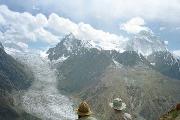 The cavalcade turned up a little below us, so we scrambled down to join
them for the usual packed lunch - at 4190 metres according to the folks
with the GPSes. Just around the ridge there were great views of the
Chantiboi/Darkot glacier and the 6800m peak of Koyo Zom to the south.
I walked down with Brigitte and Gerard, Vera and PeterK following behind.
It took just one hour going down!
The cavalcade turned up a little below us, so we scrambled down to join
them for the usual packed lunch - at 4190 metres according to the folks
with the GPSes. Just around the ridge there were great views of the
Chantiboi/Darkot glacier and the 6800m peak of Koyo Zom to the south.
I walked down with Brigitte and Gerard, Vera and PeterK following behind.
It took just one hour going down!
I washed some clothing only to have it became dirtier than before,
as usual, even though I rinsed it in spring water. Then I read some
more and sat on a convenient rock looking at the river. This was
quite a torrent, with powerful waves tossing dirty mica-laden glacial
melt. Swimming was impossible and anything dropped would have been
gone, to be found way downstream, if at all. It was also very noisy,
apparently from rocks moving. But Riaz told me that it almost dries up
for most of year, with July and August high water months.
After dinner we borrowed a pack of cards from the cooks - a quality
plastic deck, even! Ruth, Hawas, James, Gilbert and I played, with Riaz
and Javed advising and PeterC watching. It was a basic trick taking
game with bidding, with scores plus or minus 10 per trick bid, depending
on success, and 1 for each overtrick; bidding 0 or 1 was not allowed...
I came last. An early night - 9.20pm finish.
I slept in a tent with Art, who told
me I was "gung ho" (which I took as a compliment). It was cold during
the night - there was frost on some of the tents in the morning.
Monday 30th August: upstream
My washing was damp. And then the sun suddenly hit, as it does in that
sort of terrain. We stood around talking as the horses and yaks arrived.
I tried to talk people into climbing a small hill (maybe a thousand metres
above us) to the south (above our camp site) but there were no takers.
So we all set off upstream. I walked with Riaz and Amjad; the horses
took another route.
We stopped at a place where the path went between huge rocks on
either side. Gerard climbed up to a watchtower on one side, I climbed
the other. And Pat and Ruth and I explored an abandoned house nearby.
Then we wandered a few hundred metres on and spent an hour or so looking
for fossils on a limestone scree slope. I found lots of brachiopods
and conoids and Vera found a trilobite (?the pygmidium of an ascidia??).
It was hot, so after a while I sat with Ruth in what little shade
we could find (on top of some dried goat dung) and then with Vera and
Pat while Ruth did cartwheels and other gymnastics (until she found
she was attracting attention from all the horsemen and stopped).
Pat explained that she'd gone to Amsterdam when 14 with a gymnastics
team - and Ruth told the history of her nose piercing, acquired on a
later trip to Amsterdam.
I sampled a tiny bit of dolostone from the Chilarabad formation for Ronni![[ext]](ball.gif) (who had requested some rocks).
We had our usual lunch before heading back. (who had requested some rocks).
We had our usual lunch before heading back.
On the way I followed the horses until we reached a side-river
which had risen, and which the horses and horsemen had quite some
trouble crossing. I decided against it and went back and around by the
pedestrian bridge I had used on the way out. We got back around 3pm.
Gary was lying under my fly - apparently it was the coolest place to
be found! Talking with John and Brian and others in the mess tent,
there was an undercurrent of hostility to Hawas.
Meanwhile Hawas and Javed were paying for yaks and horses and arranging
porters and animals for the following day. They sat in the tent with
the horsemen gathered gesticulating around them. (I could picture a
nineteenth century British explorer paying porters in a very similar
scene: there is some authority inherent in sitting in a tent while others
stand around.) It was quite complex: Hawas spoke no Wakhi and I think
some of them had little Urdu (and the same names), and the work had to
be spread around the different villages lest it upset local politics.
I borrowed Pat's copy of Barchester Towers and read fifty or
sixty pages of that - I couldn't really imagine anything further removed
from where we were! I had to fetch Hawas and Ruth from down by the river
when it was dinner time: afterwards the three of us sat and talked again,
but only till 9.30.
Tuesday 31st August: back to Lasht
It had been decided to return to Lasht in one day. With a 35 or
40 kilometre hike ahead of us, we were up at 5.30 and left between
7 and 8 after the usual milling, so we straggled out over about 5km
right away. I started off with Riaz and Amjad, then stopped for half
an hour watching the Chantiboi glacier. I walked down to the glacier,
but a little side-stream was enough to stop me getting right up to it.
After that I stayed with Ruth and Hawas. We had lunch at Kishmanj,
where I made the mistake of washing myself but not drying off properly,
which resulted in nappy rash on the final stretch. Some of the terrain
(scree slopes with nasty medium-sized rocks) was very hard on the horses
and I think the riders really should have dismounted for a lot of it.
On the way to Kan Khun Ruth gave her horse away and we and Hawas ended
up at the tail of the group, with Pat until he took a horse and then with
Gilbert, who didn't like riding and walked slowly
but steadily. At Kan Khun they had left some horses to ferry us across
the stream and the others rode the rest of the way. I had to speed up a
bit to keep up with the horses (Ruth wanted to canter but the horseman
wouldn't let her: she had enough trouble getting him to let her take
the reins). Near the end Vera and I loaded up with water from a spring,
since we weren't sure of water at the campsite, so I trotted into camp
carrying maybe fifteen kilograms.
The road had been fixed, so we camped in Lasht. Some peoples' luggage
was late arriving, as it had been put on yaks, which were a lot slower
than the donkeys. (We wondered that the yaks had made it along some
of the tracks at all.) My blisters were bad, as expected, but that was
all the trekking for the trip. I was the last to go into the tents again.
|
|
Travelling: Sleeping
Physically the trip was not that taxing, but it involved more exercise
than I usually get. And mentally I was idling for most of the trip
(though I started writing more towards the end, even some poetry).
For whatever reason, I found I could get by with five or six hours sleep
a night instead of the eight or nine I need normally: I was regularly
going to bed after midnight and waking up around six.
I ended up sharing a room or tent with as many as ten different
people at one time or another: John, Hawas, Art, Gilbert + James, PeterC,
Shah Jahan, Ruth, Bruno, and Myriam. (Of the single people, I figured
I was the best able to cope with this, so I usually waited till the end
when room allocations were being done. The unpredictability did start
to get a bit stressful towards the end of the trip, though.)
|
|
Geology: Mountains and Tectonics
The tectonics of Pakistan is convoluted but exciting: the basic India-Asia
collision is complicated by the intervening Kohistan island arc and
possible early impacts, with bits of Gondwanaland and Laurasia breaking
off ahead of the main impact.
But it was the geomorphology that was most arresting. The mountains,
obviously, but also the erosional features carved
out of them...
|
People: Ruth and I
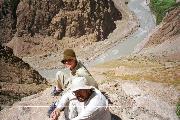 Ruth and I on Kuragh ridge.
Ruth and I on Kuragh ridge.
At Ishkarwaz I told Ruth I was a quarter of
the way to being in love with her, which seemed to make sense at the
time. At later times I wasn't at all sure: some of the symptoms of
limerence were very pronounced, even if
others were entirely absent. In the end, I think it was mostly emotional
dependency brought on by the pressures of travelling.
Anyway, I felt really comfortable and relaxed with Ruth and we had a
lot of fun together. It is most unlikely we would ever have met in the
normal course of events, but I hope we stay in touch: it's good to have
(differently) crazy friends.
When I told Ruth we were like cousins, she suggested brother and sister
instead (whether because it fitted better or because it was a safer degree
of consanguinity I'm not sure). Unfortunately I don't think Qantas'
employee benefits scheme extends to cheap airfares for honorary siblings.
|
|
Travelling: Coping
Physically I was in close to perfect shape for the first half of the
trip: no health problems (bowels like clockwork even) and no problems
with fitness, even at altitude: blisters and nappy rash were temporary
and minor problems. But after the grapes did us in
in Gilgit I don't think I was ever really 100% again: intermittent
diarrhoea, sometimes a slight fever in the mornings, and so forth.
Emotionally and psychologically the trip wore me down slowly
(pathetic fallacy: just as everything around us was being eroded). It was not so much the travelling
itself but the consequences of too much of it - having to settle in
to a new place every night (often not knowing with whom I would be sharing a room or tent). Towards the end of the
trip it became harder to reach out to new people and I fell back on
those I felt most comfortable with.
Some of the group never really seemed to cope: some were clearly
relieved when they were heading home. The older participants seemed to
cope as well or better than the younger ones.
| |
People: James
James came from a background foreign to me: he was a rugby player,
into drinking, etc. He collected a huge number of different hats,
maybe a dozen, and he looked like a local in a shawar kamiz
and a Chitrali cap.
 Tom and James at Kishmanj.
Tom and James at Kishmanj.
| |
Travelling: Writing
Many of the group kept diaries, ranging from short notes to quite
serious undertakings. Mine took the form of extensive but cryptic
jottings, often subsequently unreadable even by myself, intended as the
basis for this report (photo).
(I sometimes wrote in moving vehicles, which didn't help things.)
Ruth wrote copious amounts of connected prose, but not for anyone else
to read. (I showed her portions of my notes when I thought they'd be
interesting.)
I didn't write many postcards. But as the trip progressed I wrote more
and more in the back of my notebook: attempts at emotional self-analysis,
mini-essays (some of them now incorporated into this report), and even
some poetry.
If we'd been travelling a little longer, I might have relearnt how
to write connected prose without a computer!
| |
People: PeterC
PeterC was a fellow bushwalker, but I failed to talk him into any
mad mountain climbs. The travelling and altitude sickness knocked him
about quite badly, I think.
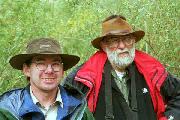 PeterC and Gilbert at Kishmanj.
PeterC and Gilbert at Kishmanj.
| |
Equipment: What Was Useful
I used my medical kit more than ever before on a trip - for stemetil,
gastrolyte, panadol, rehydration salts, and immodium. I appear to have
survived not taking anti-malarial drugs: apart from a few in the first
few days in Peshawar, I saw and heard no mosquitoes (and I haven't come
down with anything, though that could happen for several months yet).
Taking a tent fly rather than a full tent was a bit of a gamble,
but Vera and PeterK were using my only decent tent and I didn't
want to have to carry a tent just for myself. I only used the fly once, but there was nowhere it wouldn't have been adequate.
If we'd been camping any higher, however, or it had been any other season,
then I think it would have been dodgy.
Not having a watch was never really a problem, though I was late for
meals once or twice a result.
Thanks to others being generous sharing their photos, not taking a camera wasn't a disaster.
| |
Travelling: Food and Cooks
Four cooks accompanied us for the first part of the trip, from Nagarh
to Gilgit: they fed us whenever there was no hotel or restaurant to
eat in. Javed and Eisa Khan had the most English and were the only two
I really talked to.
They tried to get to our camp-sites ahead of us to prepare. They would
put up our huge mess tent - big enough to sit twenty people, cross-legged
on the floor, and to stand up in - and their own cooking tent.
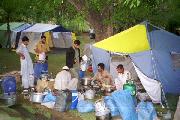 Mess tent, cooking tent, and cooks at Sonogarh
Mess tent, cooking tent, and cooks at Sonogarh
Some of the food was taken out of tins, but much of it was fresh - the
chapatti were freshly made (and often kerosene flavored) and meat was
usually freshly killed - so it often took quite some time to prepare
dinner.
While trekking a typical breakfast was: porridge, chapatti, fried
egg, and apple and mango jam. Lunch: dried apricots, apricot kernels
(like almonds), dry biscuits, tinned sardines and tuna, sultanas, dates,
caramel sweets, and tinned fruit. Dinner: rice and chapatti, okra,
potatoes and peas, goat, fried chicken, chips, and once or twice jelly
for dessert. Meals were regularly accompanied by big thermos flasks
with unpredictable contents: tea of different kinds, hot milk, hot water.
| |
People: Gilbert
Gilbert carried a golf club and half a dozen balls with him throughout
the trip, even up the Yarkhun. He practised driving wherever given half
a chance, notably at all the major passes we crossed!
| |
Travelling: Organisation
There were some problems with the organisation, mostly caused by
communication failures; people were never properly informed of what was
planned and there was poor communication between Hawas and Shah Jahan
(the tour guides responsible for implementation) and John (who made the
ultimate decisions, I think). I think John was too laid back and Hawas
wasn't assertive enough (and a little distracted,
too).
But a lot of it was probably unavoidable - when travelling through
some of the most rugged terrain in the world, in a country with poor
transport infrastructure, some problems are inevitable. The tour guides
also had to coordinate bookings through their head office in Islamabad,
which didn't help things.
Vera was surprisingly upset by the organisational problems.
I sympathised, but it didn't really bother me, I think because a) I was
in "Asia travelling mode", where I simply wasn't going to let delays or
aimless milling upset me, however pointless or frustrating and b) I was
travelling with Hawas most of the time, which meant I had more control
over what was happening. (The others could only talk to their drivers,
who had little English and didn't always know that much anyway.)
On a few occasions I was sorely tempted to take over the organisation
of the trip... but it wouldn't have been worth the trauma.
| |
People: Hawas
Hawas was our tour guide (except in China). He was a geology student
at Peshawar University, but also ran a small gemstone business and worked
as a tour guide (as almost everyone who spoke good English in northern
Pakistan seemed to).
I spent a lot of time with Hawas, so I got to know him well.
He was open, transparent, and warm. He picked up quickly on my odd
sense of humour and was generally quick to understand (my normal spoken
English was a bit much for him, but then it taxes many native speakers).
On several occasions I almost felt I could read Hawas' mind.
Hawas fell for Ruth in a big way.
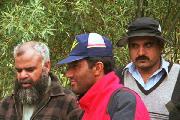 Riaz, Hawas, and Amjad at Kishmanj
Riaz, Hawas, and Amjad at Kishmanj
| |
Background: Hospitality
The Pakistanis I met were almost overwhelming hospitable. From the
vice-chancellor of Peshawar University to Wakhi pastoralists at Baroghil,
people everywhere made us welcome.
Fazli in particular was a model host: as an organiser of the conference
he obviously felt personally responsible for us. Hawas was forever
asking Ruth and me "are you ok?", even when we were patently happy.
(Among the very first Urdu phrases we learnt
were "don't worry, it's ok", "it doesn't matter", and similar others.)
And the postgraduate students who looked after us in Peshawar suffered the
indignity of having to shepherd mad foreigners around far more willingly
than a similar group of Australian postgraduates would ever done.
Hospitality, or melmastia,
is particularly important to the Pathans.
|
|
![]() .
.

